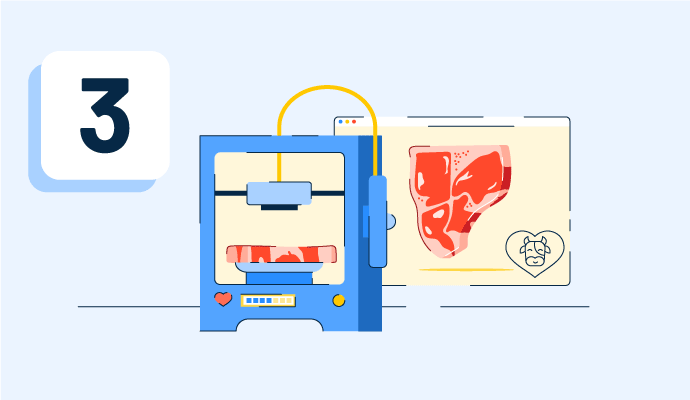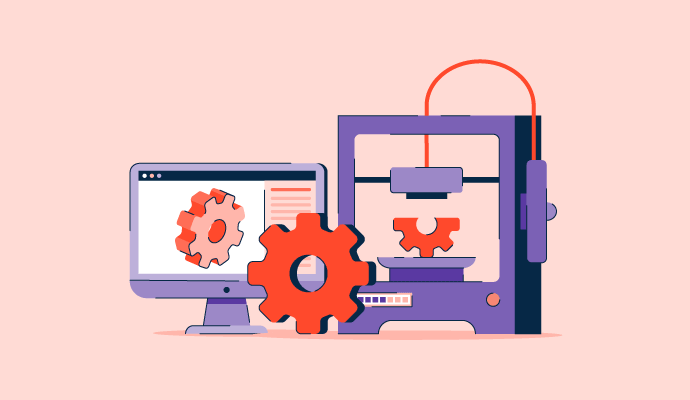What is 3D printing?
3D printing is the process of constructing three-dimensional objects layer by layer. Also known as additive manufacturing, it’s the opposite of subtractive manufacturing, which refers to cutting or carving a finished design from a bigger block of material, like sculpture.
Commonly used 3D printing materials include thermoplastics such as acrylonitrile butadiene styrene (ABS), metals, resins, and ceramics.
3D modeling software makes 3D printing possible. It allows for more creativity and experimentation by making prototypes quickly, easily, and cheaply. Because it can make detailed, complicated designs with less material than subtractive techniques, such as drilling, welding, and injection molding, 3D printing reduces material waste.
Once the design is ready, 3D printing software builds up layers of material to form an actual three-dimensional object.
Components of a 3D printer
To better understand the types of 3D printing, some important components of 3D printers are discussed below.
- The controller board is the heart of a 3D printer since it transmits instructions to all other components. It also determines the right melting temperature for shaping the object to be printed.
- The filament is the raw material needed for printing objects. It's a plastic that melts instead of burning when warmed.
- The frame houses all the electrical and mechanical elements of a 3D printer. It keeps them in position and offers a surface for printing items.
- The print bed is where the final 3D object is created.
- The print head is the component through which the filament enters, melts, and eventually takes the shape of the object to be printed.
- Threaded rods allow the 3D printer head to move up, down, and in zig zag formations.
- Stepper motors within a 3D printer aid in the construction of an object in several little steps. They also help move other components like the printer head, bed, rods, and screws.
- Belts are another motion component of the 3D printer. The stepper motor is coupled to the drive gears via belts that fit over the gears and allow them to move smoothly with the motor.
- End stops tell the printer its position and prevent it from exceeding the allowable limits. They help the printer hold its axis and avoid derailments.
- The power supply unit (PSU) supplies power to all other components of the printer.
Types of 3D printing
The international organization for standardization (ISO) classifies three-dimensional printing technologies into seven classes. All 3D printing techniques fit under one of the following categories.
- Binder jetting deposits a thin layer of powdered material, such as metal, polymer sand, or ceramic, onto the build platform, after which a print head drops adhesives that bind the particles. Binder jetting prints 3D metal, full-color prototypes, and large-scale ceramic molds.
- Direct energy deposition employs a laser, electron beam, or electric arc to fuse wire or powder material. The technique builds layers horizontally and stacks them vertically to create parts.
- Material extrusion, or fused deposition modeling (FDM), supplies a spool of filament supplied to an extrusion head with a heated nozzle. The extrusion head heats, softens, and lays down material at predetermined positions to cool down and create a layer. The build platform then slides down to move to the subsequent layer.
- Material jetting deposits liquid material from one or more print heads on a surface, instead of ink on a page. Every layer is cured before stacking. Material jetting needs support structures built of water-soluble material which can be wiped clean after completion.
- Powder bed fusion (PBF) is a technique in which heat energy, such as a laser or electron beam, is used to selectively fuse regions of a powder bed to produce layers, which are then stacked to build a component.
- Sheet lamination has two distinct technologies: laminated object manufacture (LOM) and ultrasonic additive manufacturing (UAM). LOM utilizes alternating layers of material and adhesive to make products with visual and aesthetic appeal, whereas UAM combines thin metal sheets using ultrasonic welding.
- Vat polymerization comprises stereolithography (SLA) and digital light processing (DLP). These techniques generate components layer-by-layer, using a laser to selectively cure the liquid resin in a vat. SLA applies a single-point laser or ultraviolet (UV) source for curing, but DLP projects a single picture of each complete layer onto the vat's surface.
3D printing technologies
Sintering, melting, and stereolithography are the three primary forms of 3D printing techniques.
- Sintering is a process that creates high-resolution objects by heating the material without melting it. Metal powder is used for direct metal laser sintering. Thermoplastic powders are used for selective laser sintering.
- Melting methods of 3D printing include powder bed fusion, electron beam melting, and direct energy deposition. These techniques employ lasers, electric arcs, or electron beams to print things by fusing materials at high temperatures.
- Stereolithography uses photopolymerization to produce parts. This method selectively cures and solidifies a cross-section of an object by joining the proper light source with the material.
Benefits of 3D printing
In comparison to conventional manufacturing techniques, 3D printing technology has several advantages. Among these benefits are those associated with design and cost.
- 3D printing creates complex, custom geometric pieces that are straightforward and inexpensive. It uses less material than subtractive production processes, making it cheaper. In addition, the cost of a part is directly proportional to the material, time, and post-processing procedures, making it a cost-effective process.
- Computer-aided design (CAD) systems used in 3D printing make product changes simple and valuable.
- This procedure is ideal for prototyping tools since it allows for small batches and in-house production, leading to faster production processes that depend less on supply chains.
- 3D printing often uses plastics and metals, but components can be made from custom materials. For instance, materials with strong heat resistance, waterproofing, or strength can be used to fulfill specific requirements.
- It drastically reduces lead times via just-in-time (JIT) and on-demand production. In JIT, products are delivered straight from the supplier to the firm, bypassing the warehouse. On-demand manufacturing entails supplying a client with the right product when they need it.
Limitations of 3D printing
While the advantages of 3D printing technology are many, users may encounter some of these common limitations.
- Certain 3D-printed items, like ones made with metal, are strong, but most others tend to be fragile. Layer-by-layer construction lowers strength by 10–50% compared to subtractive construction.
- The lack of economies of scale in 3D printing makes large production runs more expensive. Furthermore, 3D printing still isn’t competitive for high-volume production.
- The accuracy of printed parts is determined by the machine and methods used. Conventional printers with less tolerance for deviation may produce significantly different components from the designs.
- Most 3D-printed items require post-processing. This may include sanding or smoothing to obtain a desired finish, removing support struts to build materials into the desired form, heat treating to achieve specified material qualities, or final finishing.
- As 3D printing as a technology is growing, a major challenge slowing down its adoption is the lack of skill and expertise in the field.
3D printing vs. injection molding vs. resin printing
3D printing is an additive printing method that layers material to form objects. While 3D printing is a slower process overall, it’s faster to set up and permits frequent design modifications. It’s better suited for complicated designs.
Injection molding utilizes a mold filled with molten material that solidifies as it cools to generate parts. The injection molding process is superior for mass manufacturing with low material waste.
Resin 3D printing is collectively known as vat polymerization. Here, a liquid photopolymer resin is stored in a vat. Most resin printers include what’s known as a vat, a container with a transparent, flexible bottom sheet, filled with photosensitive resin that cures or hardens when exposed to UV light.
Resin results in finer features than any regular 3D printer, and the completed product often requires less post-processing labor. On the downside, the build plates are often smaller, preventing the creation of larger objects.
Each production process has its own merits, and they may be used in conjunction.
Great products start with great design. Select from the best 3D design software on the market today!

Samudyata Bhat
Samudyata Bhat is a Content Marketing Specialist at G2. With a Master's degree in digital marketing, she currently specializes her content around SaaS, hybrid cloud, network management, and IT infrastructure. She aspires to connect with present-day trends through data-driven analysis and experimentation and create effective and meaningful content. In her spare time, she can be found exploring unique cafes and trying different types of coffee.



















